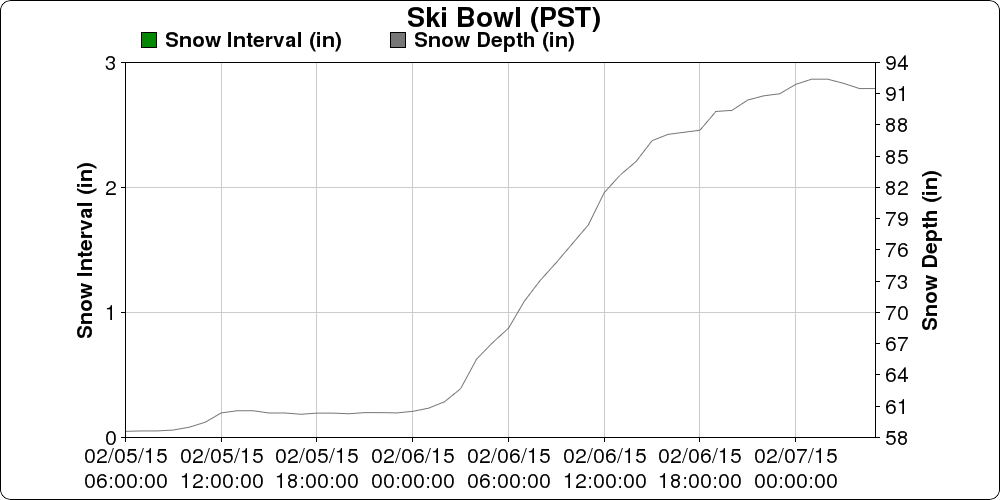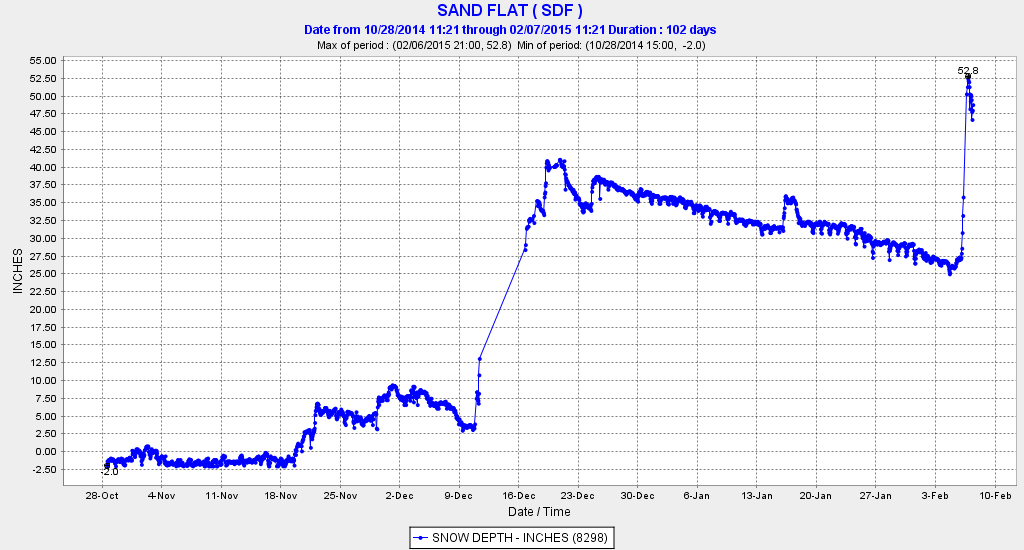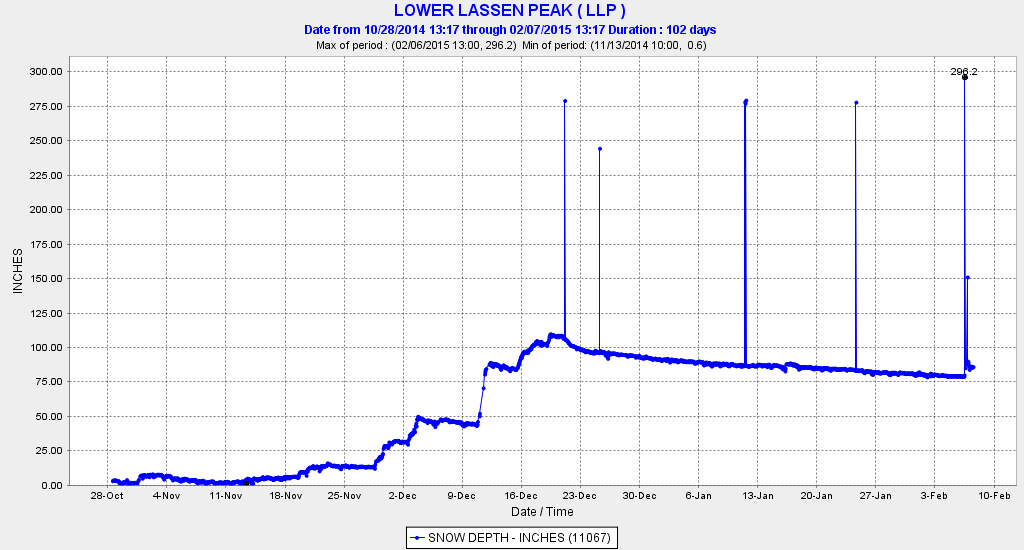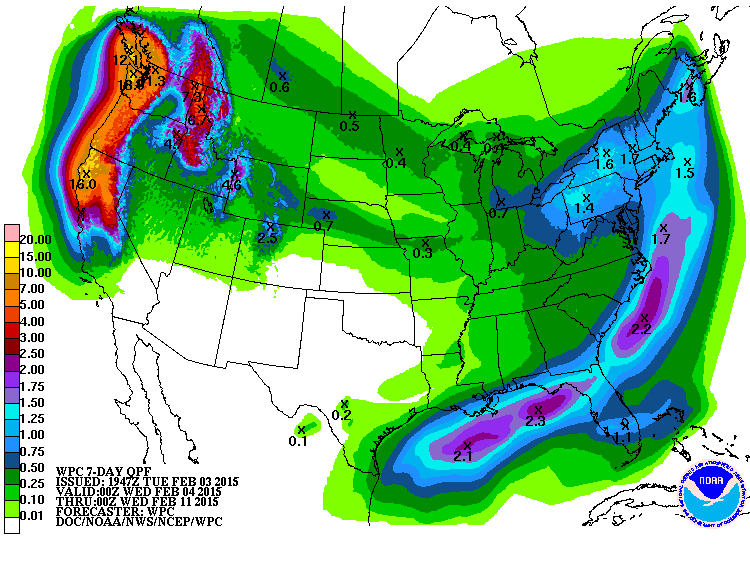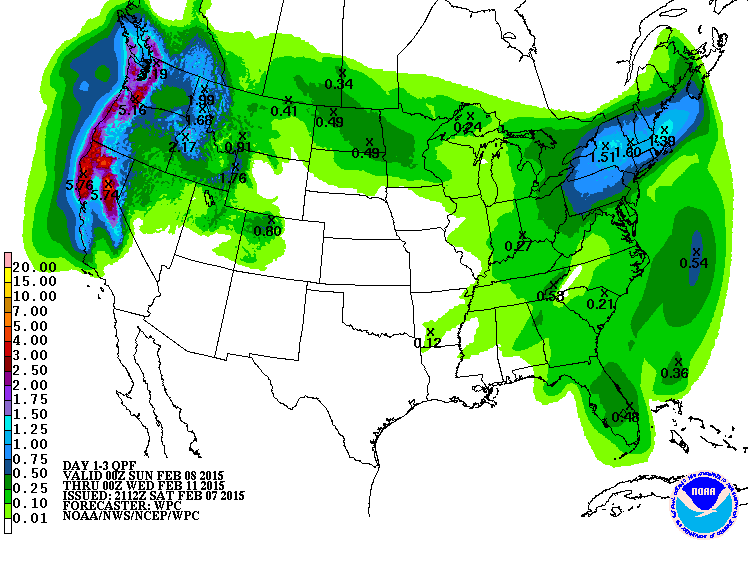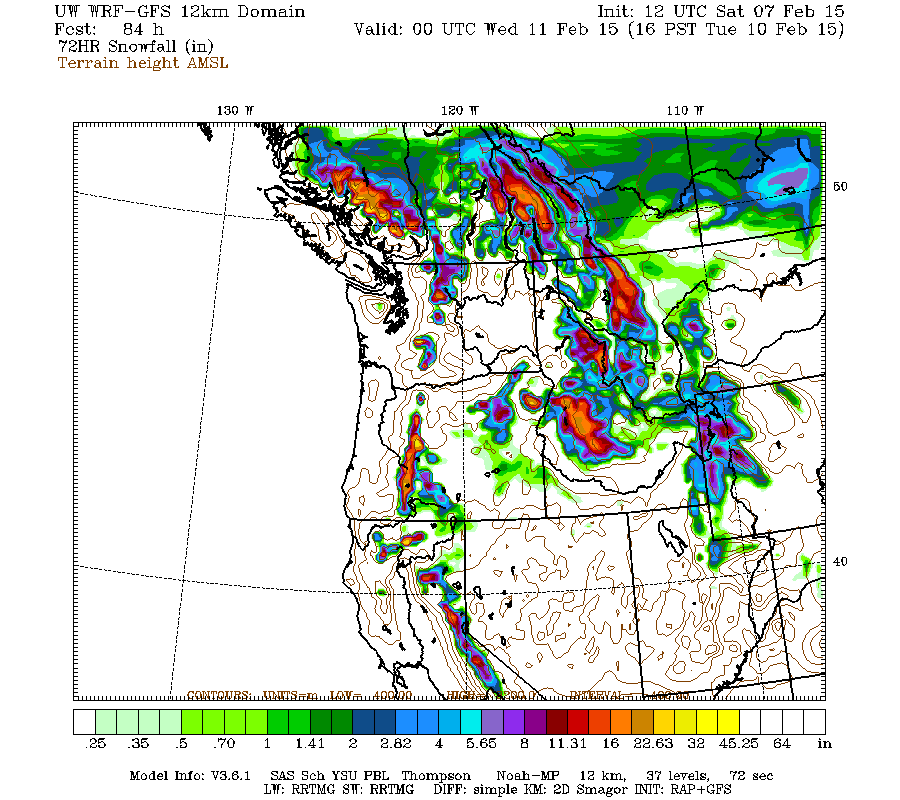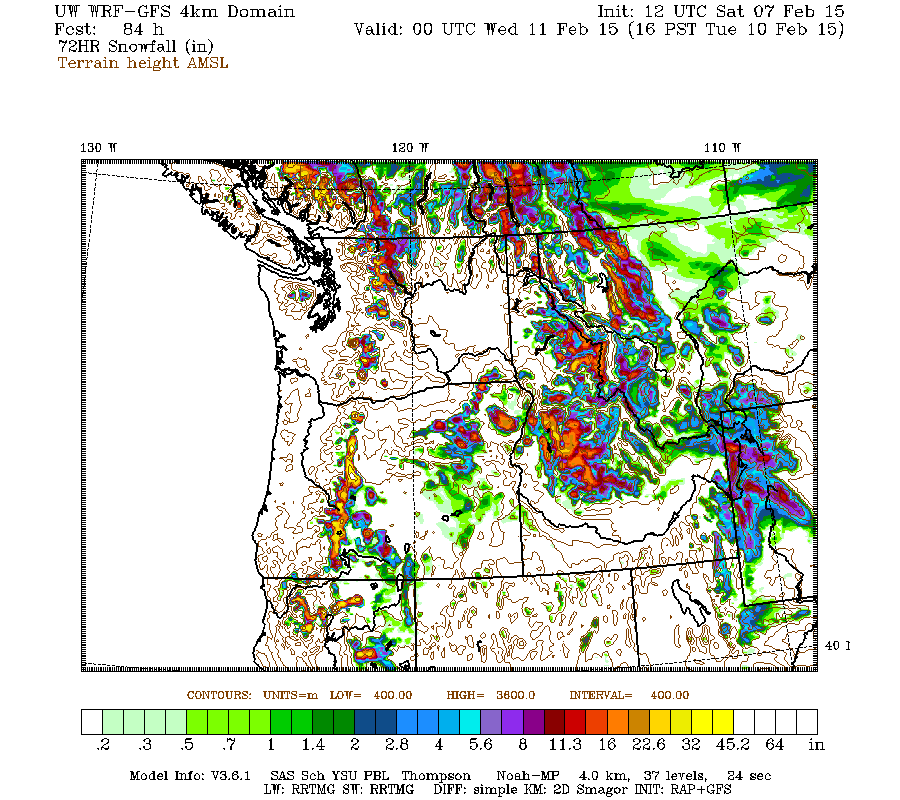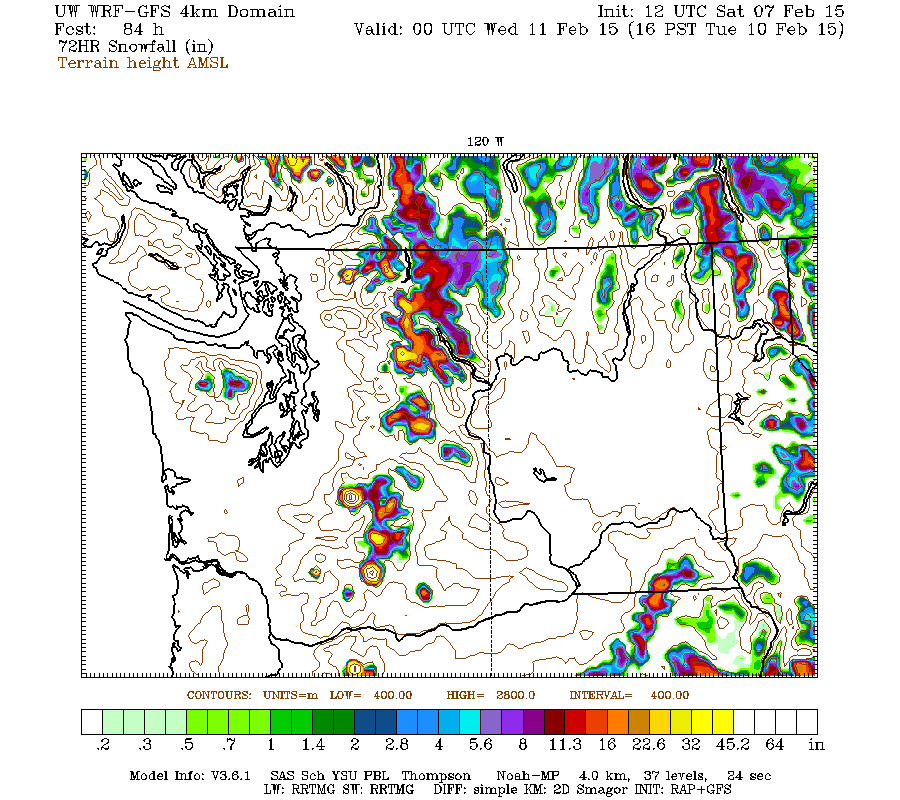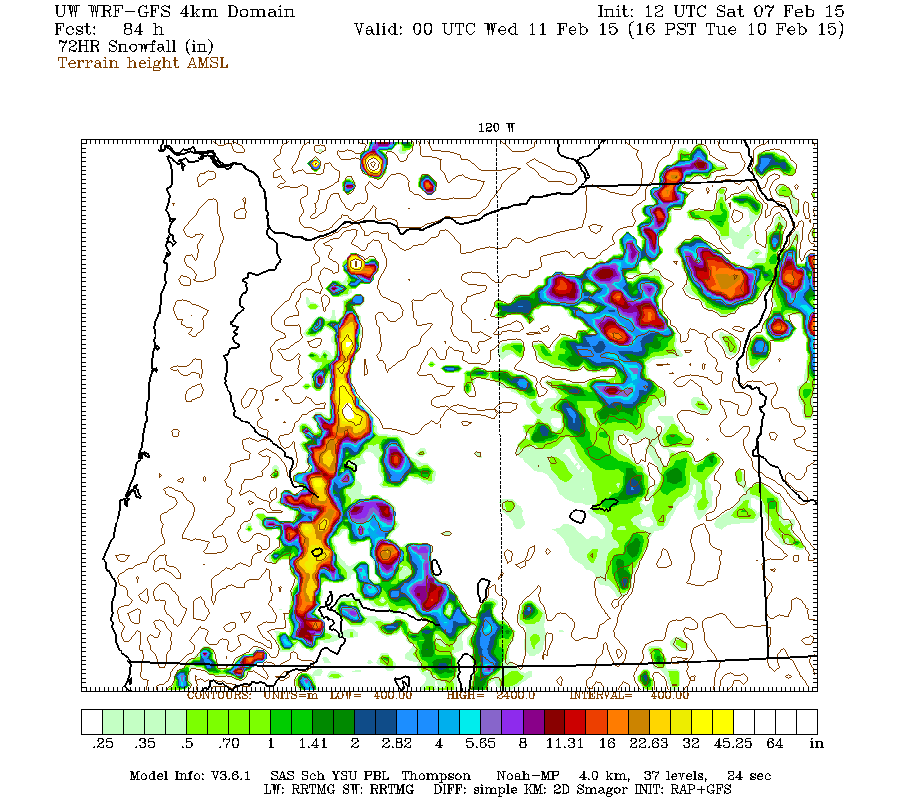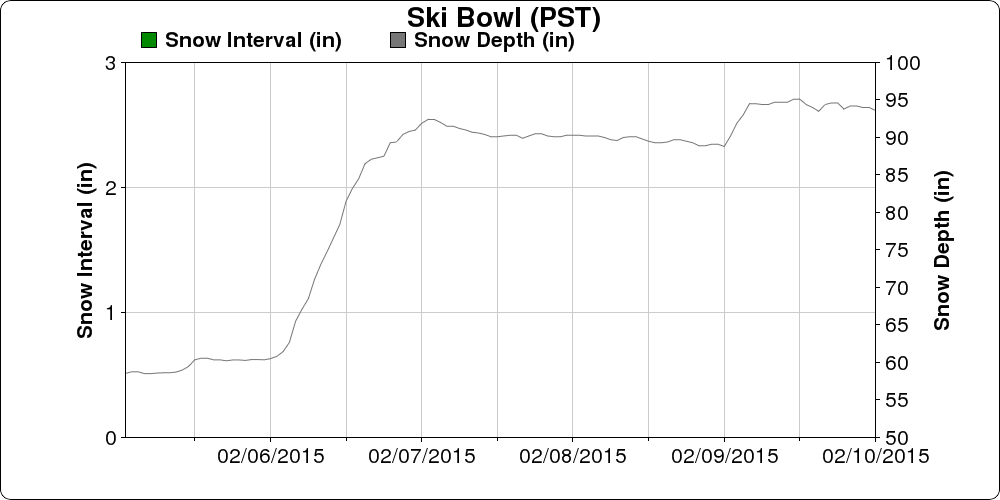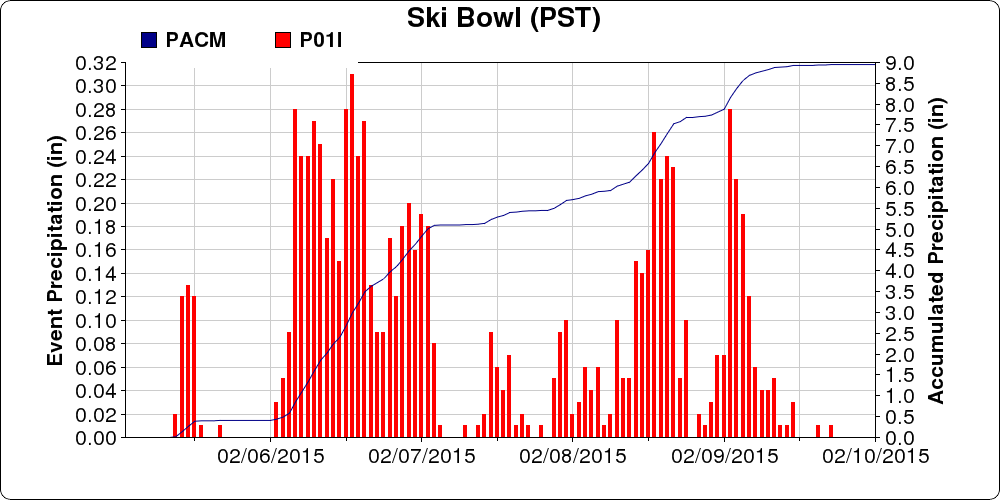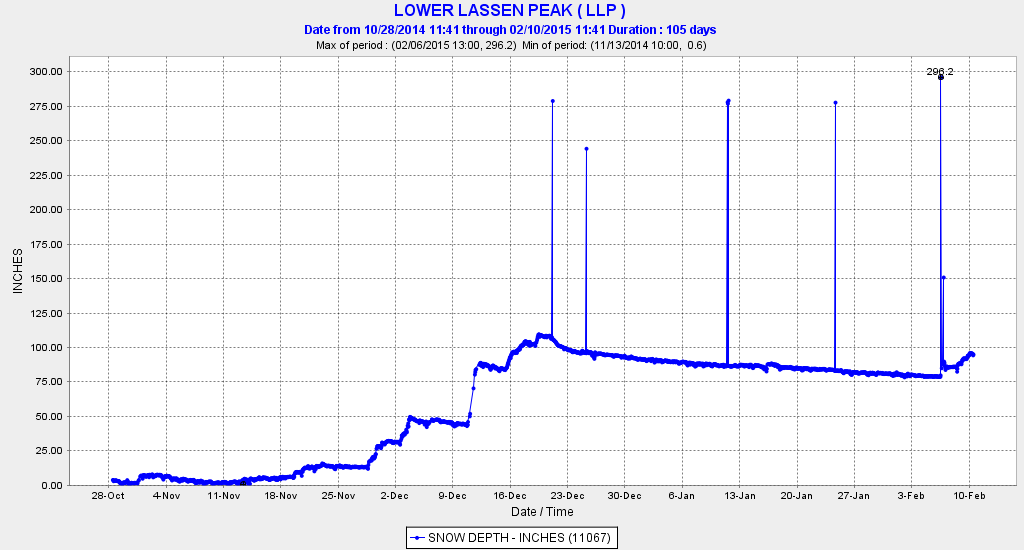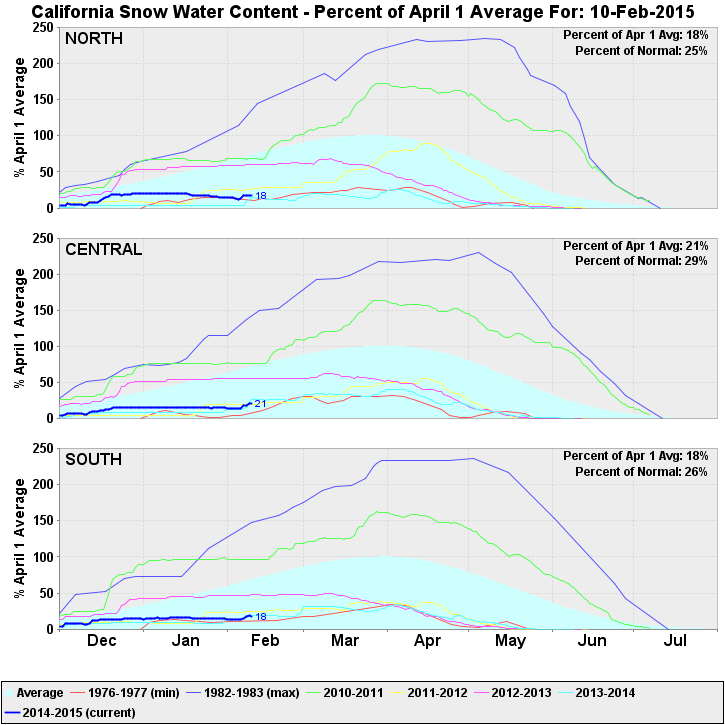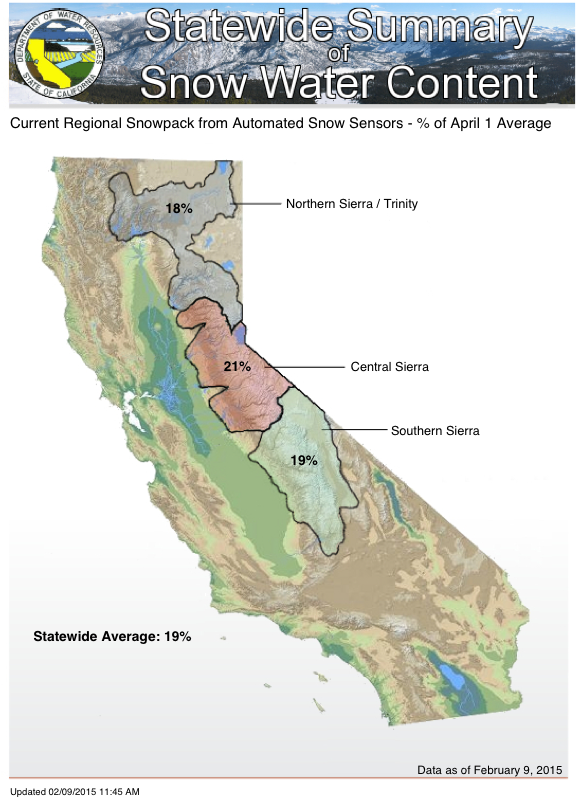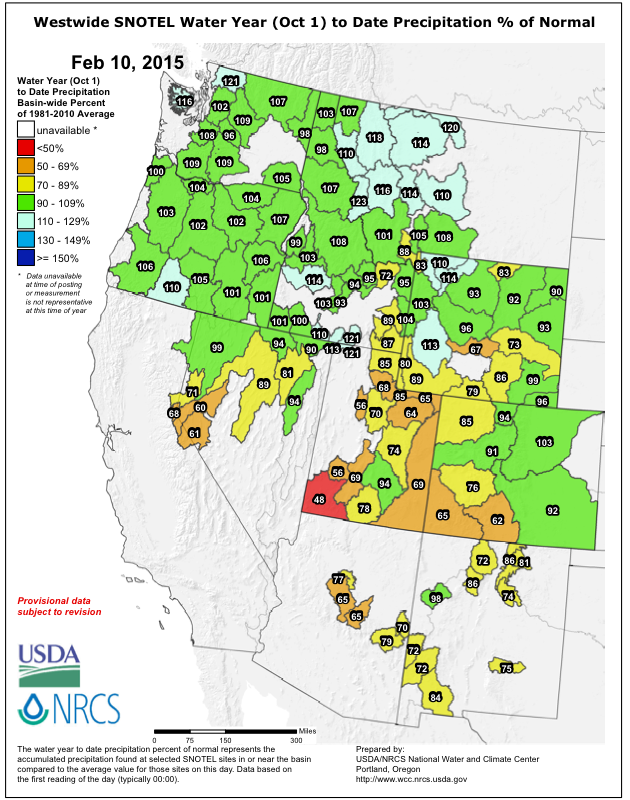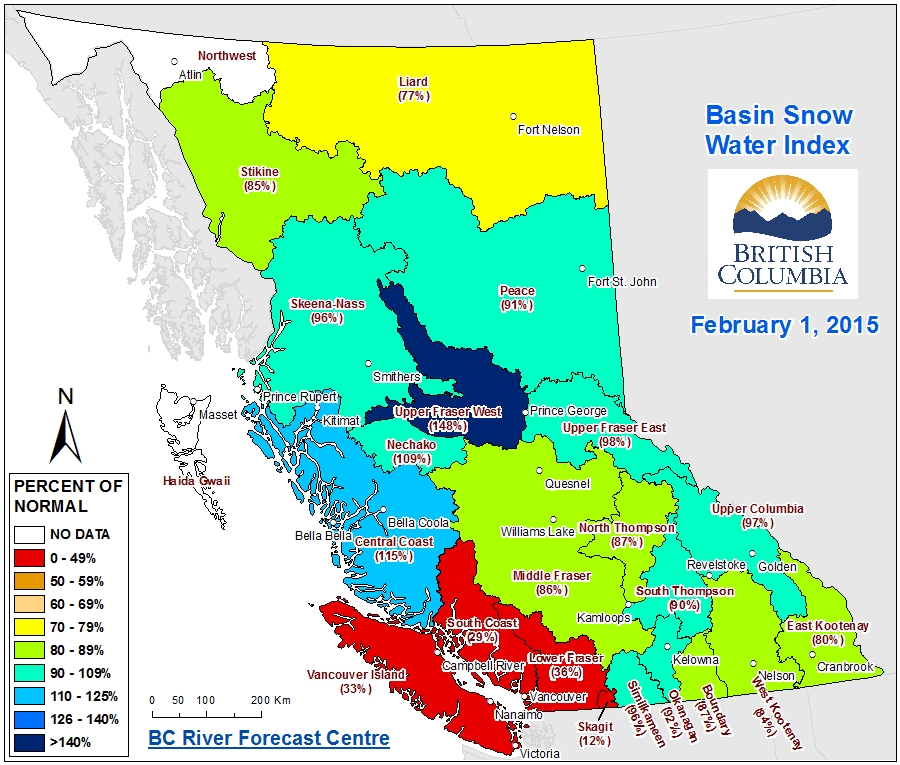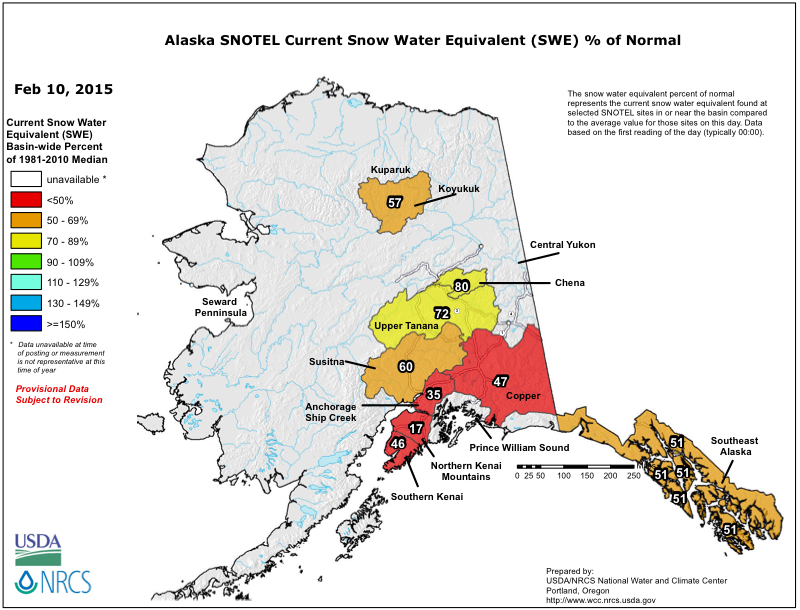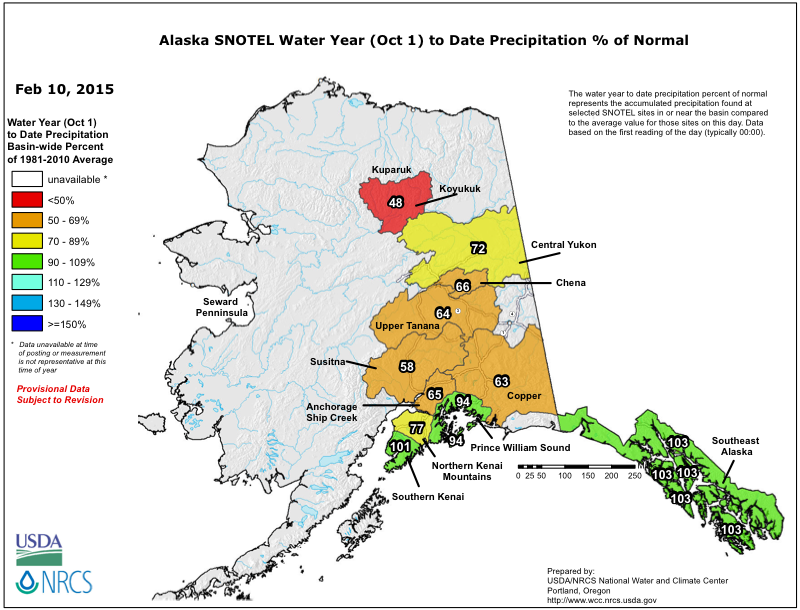- Posts: 635
- Thank you received: 0
Mt Shasta gets 3 ft new snow in 24 hrs!! 07Feb2015
- Amar Andalkar
- [andalkar]
-
 Topic Author
Topic Author
- Offline
- Premium Member
-

Lassen Peak CA reaches 100" snowdepth!! 17Dec2014
Lyman Lake SNOTEL hits 100" snowdepth!?! 05Jan2015
I'm still actively looking for positive snowpack news amid all the gloom and rain and negativity so far during this highly unusual season in the Pacific Northwest and the entire West Coast. Despite a snowpack which remains well below-normal at almost all measurement sites, making it thus far the worst season since 2005 in the Northwest, it's really nowhere near the record lows of 2005 or 1977. And the ski conditions were actually good to excellent throughout most of January as long as one went to the right places on the numerous sunny days (awesome south-facing corn from 6000 to as high as 11000 ft on many of the volcanoes from Rainier all the way south to Shasta and Lassen, outstanding smooth fast empty groomers at Crystal, etc.), and avoided obvious pitfalls like non-south-facing slopes and cloudy days and places with clearly inadequate snowpack.
So here is some more good news in the midst of yet another series of strong, wet, and warm atmospheric rivers: Mount Shasta Old Ski Bowl at 7600 ft just received 3 ft of new snow in a 24-hour period ending around 1am on Saturday, February 7, with snowdepth increasing from 60" to 92" over that period and about 4.5" of precip falling. About 24" of new snow fell in 12 hours from 3am to 3pm Friday during the most intense phase of the storm:
Lower down on Mount Shasta, the CCSS telemetry site at Sand Flat at 6750 ft also got over 2 ft of new snow in 24 hours, with snowdepth nearly doubling from 27" to 53", and there was 5" new down to the base of the Mount Shasta Ski Park at 5500 ft, which fell atop mostly bare ground at the closed ski area. Here is the snowdepth at Sand Flat over this season, unfortunately there was a data outage during the huge December snowstorm, but thankfully the site came back online afterwards:
A bit of new snow even fell down to about 4500 ft at Lassen and Shasta as colder air got pulled in around the low on Friday, while frustratingly the snow level still remained higher than that at 6000-7000 ft over much of the Washington Cascades and northern Oregon Cascades as much warmer air ended up farther north, very similar to what happened in the huge mid-December storm which dumped 4-5 ft in 36 hours on Lassen and Shasta. The region of heavy snowfall this time extended north through most of the southern Oregon Cascades as far north as Mount Bachelor, with 11-14" new reported in 24 hours at Mount Bachelor's 6300 and 7300 ft measurement sites, while Crater Lake got about 22" at the Crater Lake Rim telemetry site (7050 ft) and 18" at Crater Lake Park HQ (6400 ft) in 36 hours. There was also 19" new at Mount Ashland ski area (6500 ft) in the Siskiyous, allowing that community-owned non-profit ski area to reopen after a month-long closure due to lack of snow.
The current depth of over 90" at Mount Shasta Old Ski Bowl is just about 100% of normal for this date, although this telemetry site was only installed in December 2002, so the period of record is quite short. And it's astronomically better than last year, which had only 4" on the ground (!!) on 06Feb2014 prior to the huge February storm cycle . Yes, last year Shasta and Lassen were mostly bare ground even at high elevations into early February, an unprecedented situation in the historical record extending back over 80 years.
Surprisingly, the Shasta site has also now passed the California Cooperative Snow Surveys telemetry site on Lassen Peak at 8250 ft near Lake Helen for the deepest current snowpack of any measurement site in California. The Lassen site had settled from its late-December high of almost 110" to barely 80" prior to this storm, and only got about 10" new snow yesterday followed by rain, leaving the depth at about 86". Here is the snowdepth at Lassen over this season (ignore the 200+" data glitches), of particular note is the almost complete lack of snowfall from December 21 throughout the entire month of January and up to yesterday:
Overall, the Lyman Lake SNOTEL site at 5980 ft in the North Cascades still has the deepest snowpack of any measurement site in the United States as far as I know, with a mix of snow and rain during the past 2 days and perhaps a foot of new, with 106" on the ground as of midday Saturday. Its closest competitors in the Cascades are the Brown Top SNOTEL (5830 ft) in the North Cascades which stayed mostly snow despite temps well above freezing and got over 20" new bringing it up to 97", along with Harts Pass SNOTEL (6490 ft) which stayed mostly snow but didn't get much precip, and now has 87". In the Rockies, the Moss Peak (6780 ft), North Fork Jocko (6330 ft), and Noisy Basin (6040 ft) SNOTEL sites in Montana all have about 87-90", while the Grand Targhee SNOTEL (9260 ft) in Wyoming had 94" this morning before suddenly dropping several inches.
Update 08Feb2015: A high-elevation telemetry site in British Columbia has passed Lyman Lake over the past couple of days, and is now the clear leader in snowdepth among telemetry sites in North America as far as I can find: the Redfish Creek BCRFC site at 6840 ft in the Selkirk Mountains, located on the southern border of Kokanee Glacier Provincial Park just NW of Kootenay Lake. This is the 2nd highest snow telemetry site in BC, and has stayed all-snow during this atmospheric river event with temps remaining just below freezing. It had 96" of snowdepth on the morning of February 5, but has since received over 8" of snow-water (probably 4-5 ft of snowfall) bringing the depth up to almost 130" as of midday Sunday, February 8. This is the greatest snowdepth at any telemetry site in North America thus far this season that I've been able to find. A few other BCRFC telemetry sites also topped 100" over the past couple days, Mount Cook (5160 ft) and Azure River (5330 ft) located about 200 miles farther north in the Cariboo Mountains, and Tsai Creek (4490 ft) located just east of Terrace in the Coast Mountains over 400 miles NNW of Vancouver, but all have since settled back below that mark as of midday Sunday. (Link to view the last 7 days data at all 4 of these sites .)
There's one more major atmospheric river to come during the current storm cycle, which actually looks slightly more promising for snowfall than what has already passed during the last 2 days. Here's the prediction from a few days ago for total precip during this storm cycle through Tuesday afternoon, with max amounts of 16-18" in the Olympics and the Klamath Mountains of northern California:
And here's the current forecast for what's still to come over the next 72 hours through Tuesday afternoon, with max precip of over 5" in the south Washington Cascades and northern California:
The high-resolution UW WRF-GFS model is predicting new snowfall amounts of up to 1-4 ft over the next 72 hours through Tuesday afternoon for the entire Cascade Range at sufficient altitudes (mostly above 5000-6000 ft), with amounts up to 1-2 ft extending through the Sierra Nevada:
Higher resolution version of that, showing the Pacific Northwest and also zoomed in on Washington and Oregon:
Maximum amounts of 4+ ft (marked by white inside yellow) are shown on Mount Baker, Glacier Peak, Rainier, Adams, and Saint Helens in Washington, plus Mount Hood, Jefferson, and the Three Sisters in Oregon:
Hopefully that should provide another much-needed boost to the snowpack, even if lower elevations will miss out yet again.
Please Log in or Create an account to join the conversation.
- lrudholm
- [lrudholm]
-

- Offline
- Junior Member
-

- Posts: 83
- Thank you received: 0
Please Log in or Create an account to join the conversation.
- powhound
- [powhound]
-

- Offline
- Junior Member
-

- Posts: 52
- Thank you received: 0
Please Log in or Create an account to join the conversation.
- Floater
- [Floater]
-

- Offline
- New Member
-

- Posts: 23
- Thank you received: 0
I really did not become aware of it until the last two La Ninya cycles. We had great skiing lots of fresh snow but very few major lowland snow events. La Ninyas in the past were marked by lots of lowland snow events and longer lowland cold spells. In the past there is a lake next to us where we would be able to ice skate for a week or so. That has not happened in years. It may get a thin ice cover, but is too dangerous to try it. No our weather is changing big time. Tiger Pass used to be a real hassle due to snowfall to use in La Ninya years getting from my house in Port Orchard to Snoq. During the last La Ninyas it was a breeze most of the time getting through there. Despite the good skiing I was worried real worried.
This year I believe is a harbinger of things to come. Yes we are still getting snow but it is in intense short periods and when it is good it is awesome. Last year the season of good winter skiing was all compressed into a four week period. Oh and the January just plain sucked last year as well. All we can hope for is another weird redemption like last year. This is not your stable jet stream of the past bringing us cool wet weather to the lowlands and moderate snowfall to the mountains high 20s to low 30s for days on end during normal years. Now it is very warm periods punctuated by very intense snowfalls in shorter periods. The problem is for how much longer folks will we even get a snowpack. I would be worried.
I also think our glaciers are rapidly decreasing. I made a climb of Glacier Peak two years ago in August by a route I used 45 years ago. I was with a friend who was a mountaineer and who had done over 50 years of climbing in the Cascades. I personally am not a mountaineer. We were aghast at how much the glaciers have shrunk. They almost all have disappeared or markedly shrunk in size. It was so sad to see. I actually think this process although expected is actually accelerating.
Here is the sad thing we need the pack not so much for face shots and floating, but for water to drink and for our farms and hydro. No this is scary stuff. Our weather is getting like the SF Bay area in the winter lots of inversions heavy fog and then the occasional major rain event sometimes cold but often a pineapple. What is also scary is Northern Cali is getting like Suthern Cali use to be.
I will be honest with you folks you can look at tons of data, but the times they are a changin. Take it from someone who has lived in this area for 64 of his 66 years. Three or four years ago in what became a good snow year in January I was in a Tshirt on the top of what is left of Mount St Helens in January. Every year I have done that since then at Camp Muir and it is frequent. That happened in the past but rarely. For example 1981, but not for so many days in a row.
Buying a lawnmower and will be mowing next weekend. It is the earliest start ever at this house in 40 years and I hate mowing the lawn but it is growing like crazy. Go figure folks ....... if you can not see it happenin you are taking way too many 4:20s....LOL.
Please Log in or Create an account to join the conversation.
- aaron_wright
- [aaron_wright]
-

- Offline
- Senior Member
-

- Posts: 429
- Thank you received: 0
Yes the climate is changing, but things aren't that much different and don't fall very far outside historical norms except for a few outliers years. It's been accepted that Cascade glaciers have been receding for some time. A decade or so of some really good winters fools us into thinking we'll be skiing powder every day from November through April and that it is normal.
Please Log in or Create an account to join the conversation.
- HillsHaveEyes
- [HillsHaveEyes]
-

- Offline
- New Member
-

- Posts: 32
- Thank you received: 0
Please Log in or Create an account to join the conversation.
- DG
- [DG]
-

- Offline
- Junior Member
-

- Posts: 150
- Thank you received: 0
This is what is weird this is happening in a year that is not an El Nino. We should be fearful of that.
I'd have to agree - El Nino never really materialized this year but it sure feels like it did. What happens when a strong one kicks in?
The mere fact that ski resorts are built at places like Snoqualmie Pass and SkiBowl (3800' ft on Mt Hood) suggest that low/mid elevation snowpack used to be more dependable. Skibowl is onto its third or fourth dismal year in a row and I don't think any of those were El Ninos.
Please Log in or Create an account to join the conversation.
- Floater
- [Floater]
-

- Offline
- New Member
-

- Posts: 23
- Thank you received: 0
However early years did produce doozies in the lowlands....1969, 1955, 1950, 1916 and several ones in the late 1800s produced massive dumps in the lowlands. Some of those were showstoppers. Unless we have a massive volcano eruption, I think those days are gone for huge lowland snow events around here now if you are in Boston that is a different story.
Yes it was rare even in earlier years that you could skate on the lakes. It was about once every five years or so normally during La Ninjas as you have noted. However, it is now going on close to 15 to 20 years since the local one Long Lake was safe to skate. Recent La Ninyas have not had enough cold in them to do the trick down here at sea level, but you still got good skiing 98-99 was epic. Now during the period Amar calls the Golden Years in the 1950s and the 1960s I can remember two winters where lake Stevens froze so thick that you could drive a car on it. When was the last time that has happened since......never. I am not expecting a nice freeze on Long lake in any year in the future for skating is my prediction.
Folks the weather is changing........it is warming up....around here. Oh and in Alaska what is going on is downright amazing. The further North you go the changes are even more dramatic. If you are not seeing it you have your head in the dirt.....I would say snow but there is not enough of it to put your head in....LOL.
Please Log in or Create an account to join the conversation.
- Floater
- [Floater]
-

- Offline
- New Member
-

- Posts: 23
- Thank you received: 0
Yeah you can always go high like Shasta, but that does not leave you much of the range to play with and closes the door on a lot of ski areas. Talking big dumps over 6k is like a bad joke, it does not leave you much of the range left to play with and where you are playing is high windy and exposed which often turns the snow to crap. A pig is a pig call it what it is a pig.
Now all this could change the Sierras have always been known for their mondo dumps. I can remember in 2004-2005 it was crazy in Tahoe. The facades on quite a few of the building in Truckee collapsed and Kirkwood went crazy. I was in a car for a month down that way. Slept in my car in Kirkwood could not open the door had to climb out the window the dump was so big 60 inches overnight BE BIG in the parking lot. You could ski all the way down to the suburbs in Reno from one of the areas. It was awesome. Not this year that is what is weird it is almost as bad as here.
Please Log in or Create an account to join the conversation.
- Floater
- [Floater]
-

- Offline
- New Member
-

- Posts: 23
- Thank you received: 0
Please Log in or Create an account to join the conversation.
- Pete_H
- [Pete_H]
-

- Offline
- Junior Member
-

- Posts: 140
- Thank you received: 0
Please Log in or Create an account to join the conversation.
- aaron_wright
- [aaron_wright]
-

- Offline
- Senior Member
-

- Posts: 429
- Thank you received: 0
Please Log in or Create an account to join the conversation.
- Amar Andalkar
- [andalkar]
-
 Topic Author
Topic Author
- Offline
- Premium Member
-

- Posts: 635
- Thank you received: 0
Just to wrap up this particular thread: Mount Shasta Old Ski Bowl at 7600 ft got another 1-2 ft of heavy wet snow, along with periods of rain, during the latter half of the latest atmospheric river cycle. Snowdepth peaked at 95" on Monday, February 9, and total precip during the cycle was almost 9":
The California Cooperative Snow Surveys telemetry site on Lassen Peak at 8250 ft near Lake Helen also got about 1-2 ft of heavy wet snow, along with periods of rain, during the latter half of the cycle. It's now just barely ahead of the Shasta site with 96", once again the deepest current snowpack of any measurement site in California. While Shasta Old Ski Bowl is right about 100% of normal for this date, the normally much-snowier Lassen site is only about 75% of normal now.
Here is the snowdepth at Lassen over this season (ignore the 200+" data glitches), of particular note is the almost complete lack of snowfall from December 21 throughout the entire month of January and up to February 6, followed by the recent snowfall:
Despite a slight boost at high elevations from this very warm and wet atmospheric river cycle, the overall snowpack in California remains disastrously bad and just above record lows for this date (for real, not hyperbole like in WA!). This plot shows the snowpack throughout the state for this season, and also the last several since the huge 2010-2011 season, just prior to the onset of this historically unprecedented California drought, which is now well into its 4th year. All the heavy rain down there several times this season has not been nearly enough to break the drought. Current snowpack in all 3 regions is comparable to last year's miserable levels, and just barely above the record lows of 1976-77:
This map makes it easier to visualize the 3 regions in the plot above (note that percentages shown are relative to April 1 normals):
What does the situation in the rest of the western US look like? Here is a view of snowpack conditions from the SNOTEL network throughout the west, current snowpack (snow water equivalent) as a percent of normal remains below-normal in the Northwest. The situation has gotten much worse since early January, now far below-normal throughout almost the entire Cascade Range (except parts of the North Cascades) and even worse in the Olympics. It's really bad, but still not near record lows for this date in the WA Cascades -- it is much closer to record lows in the Olympics and Oregon Cascades:
Water year to date precipitation (since Oct 1) as a percent of normal, which in sharp contrast to SWE remains slightly above-normal throughout the Northwest, just as it was in December and January. At least we are very fortunate to not be dealing with drought:
What about farther north? The BC River Forecast Centre just released its February 1 snowpack report (daily updated maps are not available for BC, only once a month), and the snowpack in southwestern BC is also far below-normal, while most of the rest of the province is closer to normal. The central and northern Coast Mountains are slightly above normal, in sharp contrast to the southern parts of the same range:
How about even farther north? Alaska is also suffering through a far below-normal snowpack season especially in the coastal mountain ranges, worst in south-central Alaska and only slightly better in southeast Alaska. Current snowpack (snow water equivalent) as a percent of normal from the SNOTEL network:
Water year to date precipitation (since Oct 1) as a percent of normal, which in sharp contrast to SWE remains closer to normal throughout most of coastal Alaska, just as in the Pacific Northwest:
What's coming next? Very little precip is forecast over the western US for the next week, other than a moderate system in southern Colorado the next couple days and another weak atmospheric river aimed into southwestern BC:
Please Log in or Create an account to join the conversation.

